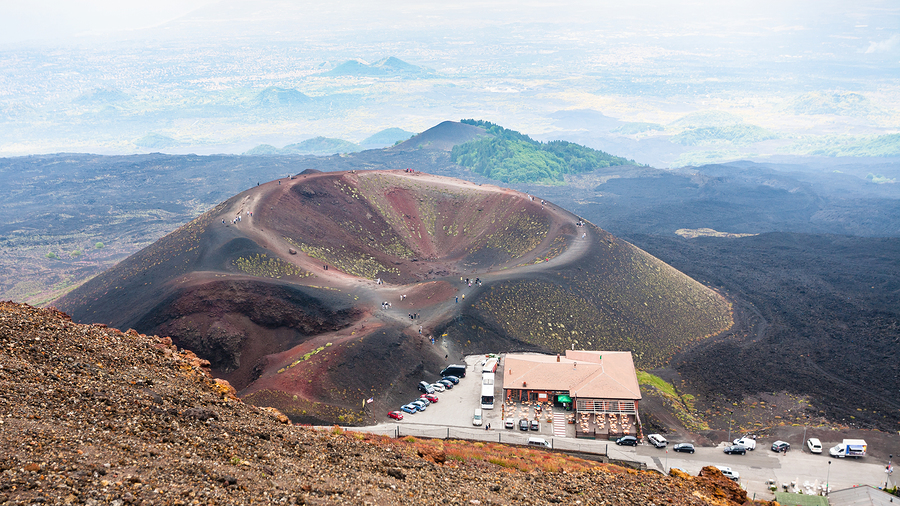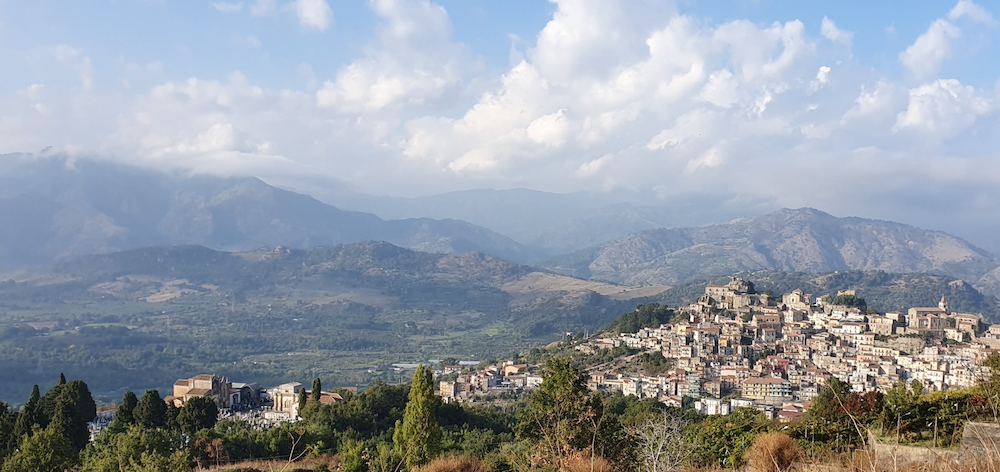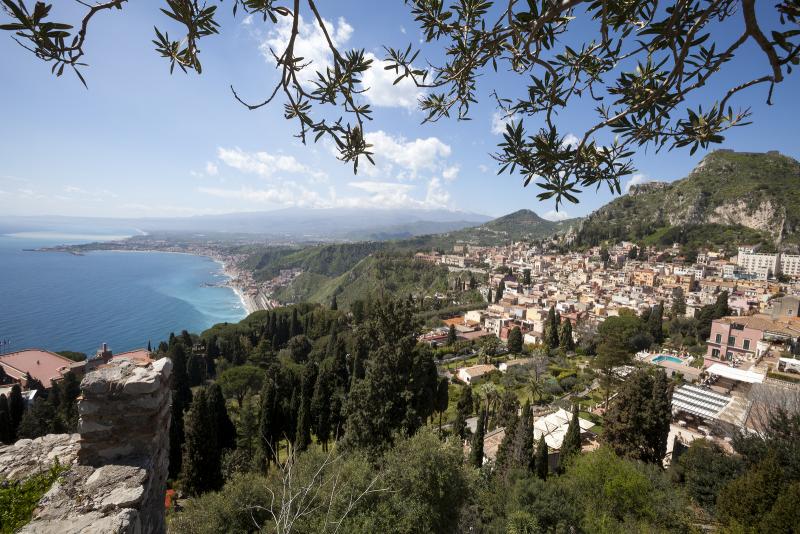“Etna giveth and Etna taketh away” is the mantra of the locals who have lived in symbiosis for millennia with this imposing volcanic peak—one of the most active in the world—that looms over Sicily’s eastern coastline. Its uninterrupted belching of ash and dust for the past 500,000 years has coated Mt. Etna’s slopes in a fertile mantle of volcanic soil, giving life to lush vineyards, orchards, and other rich agricultural lands. About once a decade, however, the volcanic cone’s cup runneth over, and magma explosions and lava flows destroy everything in their path, from fields to entire hamlets, reminding the local population that living in the shadow of a volcano is, ultimately, a risky endeavor.
As one of the most impressive natural features between the bustling port cities of Messina and Catania, Mt. Etna is on most visitors’ A-list of Sicilian attractions. The road from the Sapienza base camp up to the rumbling upper craters buzz with “moon buses” for most of the year, carrying adventurous tourists who hike the steaming lava fields and snap photos of the endless views from the highest point on the island.

By making a beeline to the peak, however, you miss out on the captivating lower slopes of the volcano, known as “the middle lands”, where the delicate balancing act between residents and their beloved yet feared mountain has left its mark on the landscape, cuisine, and culture, creating a population known for their resilience and resourcefulness. These scenic slopes are also the perfect spot to put sustainable tourism to the test, exploring by foot, bike, or train to take in areas of Sicily far from the crowds in Taormina or Syracuse and connect with local guides, farmers, and vintners.
This is the objective of the Genista Trail, a new route developed as part of the Emblematic Mediterranean Mountains project that includes nine eco-itineraries on peaks spread across the Mediterranean basin from Spain to Greece. This 60-kilometer (37-mile) “slow travel” itinerary can be stretched over five days, taking you from the towns of Nicolosi to Linguaglossa and into the wine valley along the banks of the Alcantara River between Randazzo and Castiglione di Sicilia.
Take on the entire route, or break it up into smaller legs...regardless, you will be rewarded with unforgettable vistas, some of the island’s best food and wine, and a behind-the-scenes perspective on the lives of those who have lived side by side with the “Mountain of Fire” for generations.
The Genista Trail
Nicolosi to Zafferana Etnea
The first leg of the Genista Trail takes off from Nicolosi—among the most urbanized areas on Mt. Etna’s slopes and one of two ski resorts on the mountain—and winds its way through thick holm oak and chestnut woods to Zafferana Etnea, a popular holiday destination due to its cool summer temperatures. The route climbs to Monte Arso, an extinct volcanic cone that looms over the southern slope of Etna, and passes the Casa Capinera Mt. Etna Park Visitor Center before arriving in the pretty town of Zafferana Etnea. Enjoy views over the island’s eastern coastline to one side and up to the steaming volcanic peak to the other, and visit the historic churches and picturesque squares of the pocket-sized towns of Nicolosi, Pedara, Trecastagni, and Zafferana Etnea along the way.
How to explore: This stretch of the route isn’t very well marked, so your best bet is to take it on with a local guide like Michele Buccoleri (info@onthevolcano.it). Not only will you avoid the hassle of trying to navigate your way through a series of trails and country roads with a map, but you’ll get an in-depth explanation of the volcanic flora and fauna.
Local specialties: Mt. Etna has a small olive oil production, mostly centered around the Nicolosi area. Stop at local producers like Frantoio Serafica to sample the PDO-certified extra-virgin olive oil made with heirloom Nocellara Etnea and Brandofino olive cultivars. In the slopes surrounding Zafferana Etnea, you will likely come across colorfully painted hives where more than 700 local beekeepers harvest “Etna Gold”, the area’s highly prized honey. You can sample varieties from wild flowers, almond blossoms, citrus blossoms, and more at producers like Apicoltura Privitera.
Don’t miss: Be sure to pop into the landmark Pasticceria Donna Peppina in Zafferana Etnea to try their famed fried pizza (more like a calzone); the classic version is stuffed with tuma cheese and anchovies, though there is a choice of stuffings.
Zafferana Etnea to Magazzeni (Sant'Alfio)
There is no denying you’re on the slopes of an active volcano during the second leg of the Genista Trail that runs through the scenic Valle del Bove, tracing the paths of two 20th-century lava flows that threatened the high-altitude hamlets of Milo (in 1950-51) and Fornazzo (in 1979). You’ll follow a historic mule track past the 700-year-old Ilice di Carrinu, an enormous holm oak that dwarfs the ruins of a stone cottage, to the Valle del Bove that offers spectacular views of Etna’s southeast crater. A highpoint of this leg is the Monte Fontana scenic overlook: if you’re lucky, you’ll catch the bright yellow broom flowers that cover this area during the spring and early summer and give the Genista Trail its name
How to explore: With its recent lava flows crisscrossing the route in two places and unique landscape of the Valle del Bove, you’ll want to explore this area with a volcanologist guide (see above) to fully appreciate the fascinating geology and ecosystem marking this area. The route is made up of stretches of trail and country road, and may be hard to navigate on your own.
Local specialties: The area surrounding Sant’Alfio has been known for its bold red Etna Rosso wines for centuries; according to legend, this was the wine that Ulysses offered to Polyphemus, son of fire god Hephaestus, before blinding him. Today, there are a number of historic and new wine producers putting this DOC-classified wine on the map, including Il Cantante, passion project of Mick Hucknall, lead singer of the band Simply Red.
Don’t miss: The “Castagno di Cento Cavalli”, or Chestnut of the Hundred Horses, sits near Sant’Alfio. This 2,000-year-old chestnut is said to have given shelter to Joanna of Aragon and her retinue of 100 horses and riders during a thunderstorm in the 15th century. The legend is depicted in a work by Jean Houel, which now hangs in St. Petersburg’s Hermitage.
Magazzeni to Pineta Ragabo (Linguaglossa)
Perhaps the wildest of the Genista Trail legs, this third section of the route crosses the area of Mt. Etna’s slopes that were the site of a sudden and violent eruption in 1928 that destroyed the historic village of Mascali but spared Sant’Alfio; the hike sets off from the town’s small commemorative chapel built in 1958. Spelunkers can explore eruptive fissures and lava channels, and the route passes a number of small volcanic cones and a lava flows before entering a dense forest of oaks to the Monte Crisimo saddle. The final stretch of this leg passes over a lava field formed by a lateral eruption in 2002; the young pine seedlings already blanketing the area bears testimony to the continuous cycle of destruction and rebirth on Mt. Etna.
How to explore: You’ll want a volcanologist by your side when poking around in the lava channels and fissures found along this leg, so plan to take on the route with an expert local guide for both insights into the landscape and extra safety when exploring. The team from On The Volcano (see above) are among the most respected in the area, though there are a number of hiking companies in the area that take adventurers along the Genista Trail.
Local specialties: Despite its thick forests and lava fields, this swath of Mt. Etna also produces high quality olive oil in groves surrounding Piedimonte Etneo, like that turned out by Barbagallo. To sample some of the wines produced in this area, settle in at the Enoteca del Corso in Piedimonte Etneo or go right to the source at the dazzling La Gelsomina winery in the hamlet of Presa.
Don’t miss: A meal at the rustic Rifugio Ragabo at the Piano Pernicana base camp. Alpine lodge style paired with distinctive Sicilian cuisine make for a straightforwardly delicious lunch or dinner.
Pineta Ragabo to Castiglione di Sicilia (or Linguaglossa)
Pineta Ragabo sits at more than 4,500 feet (1,400 meters) above sea level, so for most of this fourth leg you’ll be headed downhill through historic vineyards now abandoned to the encroaching wilderness and across a lava field created by a 1923 eruption. You’ll get your first look at one of the dollhouse-like railway stations of the local Circumetnea line in Cerro; here you can decide to finish your adventure in the town of Linguaglossa or continue on to Castiglione di Sicilia along a former railway route that is now a hiking and biking path. Linguaglossa is a bustling town with streets and facades boasting dark lava stone; the dramatic hilltown of Castiglione di Sicilia is considered one of the most beautiful in Sicily and overlooks the Alcantara River valley.
How to explore: This leg is one of the most simple to take on without a guide, as the route is fairly straightforward, downhill (though the longest of the five legs), and ends in two destinations where there are plenty of options for overnighting and dining.
Local specialties: Sicily may be known for its seafood, but the island also has excellent local meat. Sample thick steaks, handmade sausages, and other carnivore delights at Dai Pennisi, a historic butcher shop that recently added a kitchen and serves some of the best meat dishes in the area.
Don’t miss: Whether you’ve been hiking four days or one, you’ve earned yourself an indulgent stay at Shalai Resort, a stylish boutique hotel set in a historic palazzo in the center of Linguaglossa that boasts a Michelin-starred restaurant and full spa.
The Wine Valley (Randazzo and Castiglione di Sicilia)
If you only have time to complete a single leg of the Genista Trail, one could argue that this would be the one to choose. With an old-school train ride, biking or hiking along the Alcantara River, picturesque historic towns, and winery tastings, this stretch has something for everyone. If you are starting out from Linguaglossa, you can catch the historic Circumetnea train that chugs its way through the vineyards of the Wine Valley between Linguaglossa, Castiglione di Sicilia, and Randazzo. Once in Randazzo, take a stroll through the town to admire its soaring churches and charming old town before setting off on bike, stopping for tours and tastings at wineries along the way.
Take in the dramatic Alcantara River, hiking or body surfing through its gorge if you’re feeling adventurous, and stop to admire the 11th-century Cuba di Santa Domenica church before climbing the steep hill to Castiglione di Sicilia just in time to watch the sunset over the surrounding valley.
An alternative way to explore the Wine Valley is along the Etna Wine Route by Wine Bus or Wine Train. The association lists wineries, farms, restaurants, and accommodations along the route to help plan your trip through the Wine Valley.
How to explore: Unless you’re traveling with your own bike, you’ll need logistical support for this leg. Etna Vacanze offers wine tours by bike (or by private vehicle); Etna Discovery can organize guided hikes, canyoning, body rafting, or other activities along the Alcantara River and Gorge.
Local specialties: You are deep in Etna’s wine country now, the perfect area for winery tours and tastings to sample unique native cultivars like Nerello Mascalese and Carricante that thrive in Mt. Etna’s volcanic soil. Cantine Tornatore offers tours and tasting lunches, or stop by the Regional Enoteca located in the fortress atop Castiglione di Sicilia to sample wines from a number of area cellars.
Don’t miss: In addition to wine and olive oil, and endless array of vegetables, fruit, and nuts are cultivated in the fertile soil of Mt. Etna. Sample a bit of them all at Country House, the culinary school and tasting room founded by Santoro Conserve, one of the area’s top producers of gourmet goodies made with ingredients native to the slopes of Mt. Etna, including sauces, pestos, bruschetta patés, as well as sweet pistacchio, almond, and hazelnut spreads.













